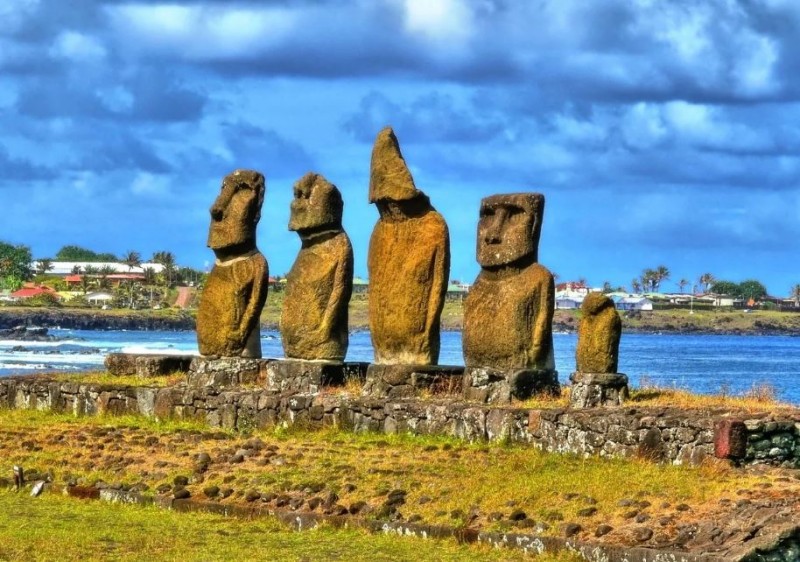
Introduction
Easter Island, also known as Rapa Nui, is a remote island located in the Pacific Ocean. It is famous for its massive stone statues called Moai. These enigmatic figures have intrigued researchers and visitors for centuries due to their impressive size, mysterious origins, and the remarkable feat of their transportation. In this article, we will delve into the intriguing world of Easter Island Moai, exploring their history, construction, and the unanswered questions that surround them.
Origins of the Moai
The exact origins of the Easter Island Moai remain shrouded in mystery. These statues were carved by the Rapa Nui people, who settled on the island around the 12th century. The prevailing theory suggests that the islanders used stone tools to carve the Moai out of compressed volcanic ash known as tuff. However, the exact techniques used to shape and carve these massive statues are still a subject of debate among experts.
Construction Techniques
The construction of the Moai involved a meticulous process that required great skill and craftsmanship. The statues were carved directly from the volcanic slopes of the island's quarry and then transported to their respective locations. The process involved intricate sculpting of the facial features, bodies, and distinct headgear of the Moai. The Rapa Nui people used various techniques such as stone chisels, basalt picks, and abrasives to shape the statues, showcasing their mastery in stone craftsmanship.
Transportation of the Moai
One of the most puzzling aspects of the Moai is how they were transported across the island. The statues are massive, with some reaching heights of over 30 feet and weighing up to 75 tons. The prevailing theory suggests that the Rapa Nui people used a combination of rolling, sledging, and upright walking to move the Moai from the quarry to their intended locations. The process was a tremendous undertaking, requiring a coordinated effort from a large number of people.
The Purpose of the Moai
The purpose of the Moai remains a subject of speculation. One prevailing theory is that these statues represented ancestral figures and were erected to honor the deceased. They were believed to embody the spirits of important ancestors and act as intermediaries between the living and the spiritual realm. The placement of the Moai facing inland towards the villages further supports this theory.
Cultural Significance
The Moai hold immense cultural significance for the Rapa Nui people. They are a testament to their ancient civilization's artistic and engineering achievements. The statues were not merely decorative; they represented the islanders' connection to their ancestors and the spiritual realm. The Rapa Nui people held rituals and ceremonies around the Moai, which were an integral part of their cultural and religious practices.
The Decline of Moai Production
Despite the grandeur of the Moai, their production declined over time. The exact reasons for this decline are not fully understood. Some theories suggest that environmental degradation, overexploitation of resources, and social unrest contributed to the decline. As the Rapa Nui society faced challenges, the production of the Moai came to a halt, leaving many unfinished statues in the quarry.
Rediscovery and Conservation Efforts
Easter Island and its Moai remained relatively isolated until their rediscovery by Europeans in the 18th century. Since then, various efforts have been made to preserve and protect these iconic statues. Conservation projects have focused on restoring damaged Moai, protecting them from erosion, and raising awareness about their cultural and historical importance.
Current State of the Moai
Today, the Moai continue to captivate visitors from around the world. They are a UNESCO World Heritage site and serve as a reminder of the ancient civilization that once thrived on Easter Island. Visitors can explore the different sites where the Moai are located, such as Rano Raraku, Ahu Tongariki, and Anakena Beach. These locations offer a unique opportunity to witness the grandeur and mystery of the Moai up close.
The Legacy of Easter Island Moai
The Easter Island Moai have left a lasting legacy on both the Rapa Nui people and the world. They stand as a testament to the ingenuity and creativity of ancient civilizations. The Moai continue to spark curiosity and inspire researchers, artists, and travelers alike. Their enigmatic presence serves as a reminder of the wonders that can be achieved by human hands and the mysteries that can still lie undiscovered.
Unanswered Questions and Theories
Despite years of research, many questions about the Moai remain unanswered. The transportation methods used, the precise techniques employed in their construction, and the reasons behind their decline still elude definitive explanations. Researchers continue to develop theories and explore new avenues of understanding to unravel the secrets of the Moai.
Conclusion
The Easter Island Moai stand as a testament to human creativity, engineering prowess, and cultural significance. These giant stone statues have fascinated people for centuries, with their massive size, mysterious origins, and enigmatic presence. As visitors marvel at the Moai on Easter Island, they are reminded of the rich history and enduring legacy of the Rapa Nui people.
India's Space Program Soars, ISRO Inspires Scientific Advancement